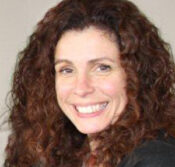Integrative Personalized
Medicine, Part 2
All over the world there seems to be a growing interest to expand traditional medical services to an integrative medical approach. There is great demand pushing up from patients while physicians are increasingly pushing down to meet their patients’ expectations to getting and staying well with means stretching beyond the boundaries of standard care. It would behoove the physician of the future to embrace additional philosophies going beyond their initial medical education & training to advance and improve patients’ health care to live and age healthy.
There is significant interest from physicians worldwide to expand their medical services to include cutting edge treatment solutions going beyond standard care. Several key reasons push Integrative Medicine to become more center stage: 1) physicians’ own drive seeking better therapeutic solutions with fewer side effects, 2) increasing demand by their patients, 3) sustaining or building a cash-based practice.
The audience of the Occidental Institute Research Foundation is unique since it has pioneered the field of Biological Medicine by its founding father Dr. Walter Sturm for over forty years. Way ahead of his time, he already had the vision to connect the German advancement of biological medicine with unique and empirical methods or technologies and make them available to initially the North American continent. OIRF’s affiliated colleagues and supporters have truly been pioneers in the field of Biological Medicine, while at the same time, the United States of America went through a progressive adaption of what was first called Alternative Medicine, then Functional Medicine and finally, the terminology settled into Integrative Medicine on a global basis. You may find it interesting to learn that the driving force behind the Integrative Medicine establishment was primarily made up of medical physicians, often leaders of regular medicine. These pioneering physicians made it their business to create the infrastructure by founding schools expanding into all 50 states and instituting state licensing to legally practice one or more forms of Integrative Medicine. The starting point of back then called Alternative Medicine encompassed only acupuncture back in the eighties for which the educational and legal structure was implemented quite rapidly.
According to the U.S. National Center for Complimentary & Integrative Medicine, a branch of the U.S. FDA’s National Institute of Health (NIH), Integrative Medicine stresses the relationship between the patient and the practitioner focusing on the whole person.
Germany is quite unique and ahead of the curve in its legal availability to the public of alternative, complimentary, and integrative medicine approaches. In a National Survey completed in 2010 it was found that more than 55% of Family Practitioners use one or more forms of integrative medicine in their daily practice while more than two thirds of German patients seek Complementary and Alternative medicine provided by physicians or licensed non-medical practitioners called “Heilpraktiker”.
Over the years, I have worked with physicians and patients from all over the world; whether at my practice in Germany, my office in New York, at their local hospital, private clinic or private home, by phone, email, texting, or by skype. Traveling to the Philippines, Saudi Arabia, China, Korea, Australia, all over Europe, and North and South America, opened my eyes and widened my experience exponentially. This sort of “medical travel” allows you to get to know a culture from a different perspective. Not as a distanced tourist, but getting right to the heart of taking part in pain and suffering and available diagnostic and treatment options in their respective country and culture. You will realize that what you thought you knew about nutrition in the West may not at all apply to the people in the East. The same goes for the people living in the South compared to living in the North of the planet. What a realization!
Quietly I observed my colleagues and patients in their dance of talking, listening, touching and expressing their emotions during their medical intervention. Humbly, I went about my way of teaching along with assessing the patient’s health situation and my multi-faceted treatment approach in which the ONDAMED is my main instrument for both obtaining a diagnostic perspective of the patient’s entire life health journey and offering treatment in a focused and personalized way.
At my Institute for Personalized Medicine in Southern Germany, I offer 2-week Intensive Healing Retreats besides my regular practice activity to my patients who come from the local villages and beyond stretching across country borders. I came to the realization that patients traveling from far, needed at least 2 full weeks of my Personalized Integrative treatment approach in order to: 1) stabilize and 2) build their health, and 3) eventually at home and overtime maintain and prevent their newly found health.
My Integrative Personalized Medicine approach includes the use of many different philosophies and treatment modalities:
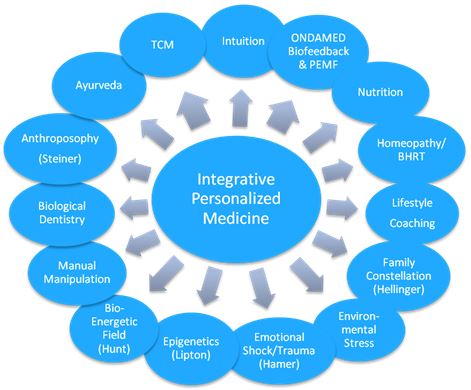
The definitions of each category are briefly defined in the following article and represent my personal opinions or that of the listed references. See Part 1 for the initial nine categories and here in Part 2 of this Issues of “The Bridge” are the remaining six categories.
Bioenergetic Field (Hunt)
A forerunner to the female brilliance of Candice Pert was Valerie Hunt. They lived their lives and careers at a time when women were not easily found in the elite leagues of science. Both women were highly educated, well trained, were actively doing research, taught within their branches of medicine at reputable universities in the U.S., and they authored research papers and books. An interesting fact is that both of their journeys brought them to an “island” of new perspective followed by the creation of new thought in the field of medicine in the 20th century.
These accomplished women passionately pursued the field of mind-body medicine, with Valerie Hunt spearheading beyond mind-body to the science of the human vibrations of consciousness.3 Valerie was born in 1916 in Indiana and passed in February of 2014 at the age of 97! She referred to herself as a scientist at work and a mystic intuitive at heart. She is best known for her pioneering research in the field of bioenergy, her visionary approach coupled with a rigorous adherence to the highest scientific standards which won her international acclaim in the fields of physiology medicine and bioengineering. As a professor at UCLA, California, she ran the first laboratory measuring and recording the energy of the vibrational patterns of the bioenergetic field surrounding the human body.
The use of ONDAMED’s Handheld Applicator (HA) allows stimulation directed toward a physiological targeted area as well as from a distance to the body. The philosophy of Hunt’s bioenergetic field and its impact on a human’s physiology and vice versa; the human’s physiology and its impact on the bioenergetic field come into play here. The practitioner can easily isolate problem areas by “vertically” scanning the individual’s body with help of the patient’s radial pulse palpation. Once the area is located, the practitioner may move the HA away from the patient’s body to identify where “horizontally” (like on a 3D image) the patient’s pulse reacts the strongest to ONDAMED’s focused field stimulation. This scanning method allows the practitioner to tap into the “energetic dysfunction” which may be on the body or at a distance from the body referred to as “the bioenergetic field” as discussed and scientifically proven by Hunt.
Manual Manipulation
Besides stimulating cellular movement from ONDAMED’s specialized applicators, it is helpful to add massage, lymph stimulation, osteopathic or chiropractic adjustments, physio-therapy, and cranial-sacral therapy.
Our observation of the patient gives away misalignments of the spine, jaw joint, shoulder joints or hip joints. While electromagnetic fields affect cellular movement from within, gentle manual manipulation may be necessary to help complete successful therapeutic intervention.
It is ideal to first expose patients to ONDAMED therapy and then follow with the manual manipulation. ONDAMED stimulation helps patients relax, improve circulation, increase blood flow to areas where applicators are placed (assuming they are dysfunctional areas as found by biofeedback method), and softening of tissue. This pre-therapy potentially eases the manual manipulation by preparing tissue, and allowing better blood distribution to stressed and weakened areas making any manual manipulation, massage, physio- or cranial-sacral therapy easier on the therapist. The combination ONDAMED and Manual Manipulation provides a more lasting effect of the manual intervention.
I have learned to also incorporate the creative work of a whole other manual manipulation: the work of a skilled orthodontist. Often I have found that structural problems in the hips may be a result of a misalignment of the jaw. A good orthodontist will view the obstruction in the mouth or jaw area from a mechanical view which impacts biological functions. Like a fine architect, a good orthodontist will use tools which apply only gentle, yet continuous force.
Being aware of better placement of the tongue is an essential ingredient to relief pressure on teeth causing teeth to misalign.
Biological Dentistry
Looking into our patient’s mouth can reveal a lot about their health.
The cooperation with a biological dentist is almost a must when we want to assure good health for our patients. Every tooth has an organ relationship since specific meridians are positioned in the area of 1 to 4 teeth (see Dental Meridian Chart in the Addendum). Any tooth decay or gum inflammation (gingivitis) affects the health of an organ and possibly correlates to emotional issues.
What Is Biological Dentistry?
Biological dentistry is concerned with the whole body effects of all dental materials, techniques and procedures.
It is fluoride-free, mercury-free and mercury-safe. Individualized testing for biocompatibility of dental materials is a must.
It insists that all clinical practice be designed of components that sustain life or improve the patient’s quality of life.
For the word “biological” refers to life.
Clinical awareness and science show us that what happens in the mouth is reflected in the body, and what happens in the body is reflected in the mouth. The complex, dynamic relationships of oral and systemic health within the context of the whole person are inseparable.
Biological dentistry unites the best clinical practices and technologies of Western dental medicine with a wide array of practices beyond its horizon.
Biological dentists may be general dentists, periodontists, orthodontists, oral surgeons or pedodontists. They also have extensive training in dental toxicology and specific modes of healing, including Traditional Chinese Medicine (TCM), Ayurveda, herbology, homeopathy, iridology and energy medicine.
While it may be impossible to construct an authoritative list of protocols followed by the “typical” biological office, all share a common paradigm: treating causes of symptoms rather than symptoms toward the goal of restoring and sustaining health.
Biological dentistry is conservative dentistry. The aim is to be minimally invasive yet appropriately active.
Ref: https://iabdm.org/
Anthroposophical Extended Medicine (Steiner)
Greek: anthropos = Human, Sophia = Wisdom
“A spiritually enhanced Medicine”
This philosophy is probably my favorite one I continue studying on a regular basis. I am lucky enough that German is my mother tongue since it allowed me to read the original transcripts by Austrian Rudolf Steiner. Much of his work is based on Johann Wolfgang von Goethe, a famous writer, poet and unknown to most, Goethe was also a major contributor of natural sciences, who in 1784 discovered and made public the incisive bone. This was an instrumental stepping stone within the evolution theory since animals and humans share the same bone. Goethe (1749-1832) may generously be compared to Shakespeare (1564-1616) in the English speaking world.
The birth of what we consider “modern medicine” dates back to 1858 when Virchow published his book “cellular pathology” in Berlin, Germany. Rapidly, Virchow’s thesis replaced “traditional medicine” which encompassed the aspect of mysticism and the perspective of a human being as body, soul, and mind basing medicine primarily on Hippocrates’ Four Humoral System:
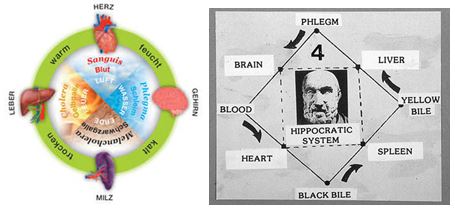
The elements air, water, fire, and earth were considered to be represented in the human body as blood, phlegm, yellow bile (liver), and black bile (spleen).
At the end of the 19th century, Virchow’s theory revolutionized medicine to what it is today: an inorganic mechanistic-materialistic medicine in which the reality of human physiology and pathology must not go beyond the cell since all living expression may be found in the behavior and action of the cell.
Rudolf Steiner was a researcher, scientist, and philosopher; he published 24 books, a large number of articles and he held close to 6,000 lectures over this lifetime.
Steiner’s idea of a “spiritually enhanced medicine” was only to be practiced by healthcare professionals who were educated in modern medicine which has respectfully been followed to this day. Anthroposophy recognizes the uniqueness of each human being. Medical practitioners must be able to act freely in their diagnosis and treatment of patients allowing them to challenge truth and science by being witness to their own observations while applying their intuition.
Anthroposophical Extended Medicine considers 4 levels of the human being:
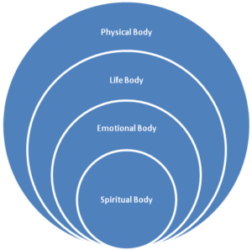
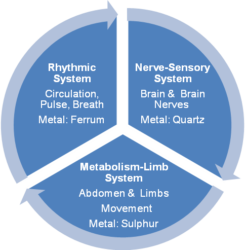
It recognizes a 3-part physiological organism
All symptoms and known diseases can be found in one of these 4 types of disease:
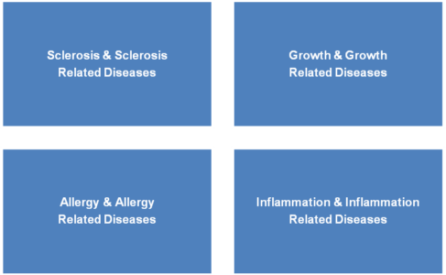
Ref: Intuitive Medizin by Volker Fintelmann, M.D.
Ayurveda
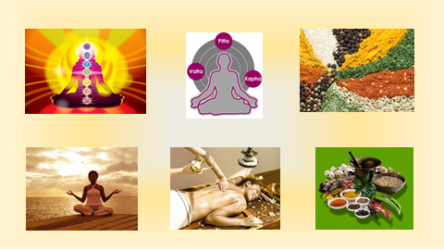
Ayurvedic medicine (also called Ayurveda) birthed in India, is one of the oldest medical systems and still today remains one of the country’s traditional health care systems. Its concepts about health and disease promote the use of herbal compounds, special diets, cleansing of the bowels, soft tissue massage using hot oil, and other unique health practices. India’s government and other institutes throughout the world support clinical and laboratory research on Ayurvedic medicine, within the context of the Eastern belief system. The Ayurvedic perspective toward the physiology differs from modern Western thought; Humans are spiritual beings living in the temple of the physical body prompting the care of health to focus on spiritual healing to affect the physical body. Another idea unique to the Eastern philosophy and yogic doctrine is the idea of chakras. Chakras are seven wheel-like vortices of energy over nerve plexes and endocrine centers of the body, as well as the third eye and the crown of the head, with small vortices at each joint. They are functional rather than anatomical structures that are connected to the meridians and acupuncture points. Numerous researchers have shown elevated electronic recordings from these locations, particularly with persons in higher states of consciousness or with extrasensory abilities. One cannot help but notice the popularity of this healing approach by finding Ayurvedic schools and practitioners not only in Asia but all over the Western world today.
Summary of the seven Chakras:
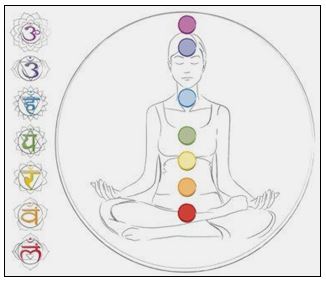
The 7 Chakras are the energy centers in our body in which energy flows through. Blocked energy in our 7 Chakras can often lead to illness, so it’s important to understand what each Chakra represents and what we can do to keep this energy flowing freely. Here’s our quick summary:
1st Chakra: Root Chakra – Represents our foundation and feeling of being grounded.
- Location: Base of spine in tailbone area.
- Emotional issues: Survival issues such as financial independence, money, and food.
2nd Chakra: Sacral Chakra – Our connection and ability to accept others and new experiences.
- Location: Lower abdomen, about 2 inches below the navel and 2 inches in.
- Emotional issues: Sense of abundance, well-being, pleasure, sexuality.
3rd Chakra: Solar Plexus Chakra – Our ability to be confident and in-control of our lives.
- Location: Upper abdomen in the stomach area.
- Emotional issues: Self-worth, self-confidence, self-esteem.
4th Chakra: Heart Chakra – Our ability to love.
- Location: Center of chest just above heart.
- Emotional issues: Love, joy, inner peace.
5th Chakra: Throat Chakra – Our ability to communicate.
- Location: Throat.
- Emotional issues: Communication, self-expression of feelings, the truth.
6th Chakra: Third Eye Chakra – Our ability to focus on and see the big picture.
- Location: Forehead between the eyes. (Also called the Brow Chakra)
- Emotional issues: Intuition, imagination, wisdom, ability to think and make decisions.
7th Chakra: Crown Chakra – The highest Chakra represents our ability to be fully connected spiritually.
- Location: The very top of the head.
- Emotional issues: Inner and outer beauty, our connection to spirituality, pure bliss.
The ONDAMED System offers 7 Chakra related programs stimulating the various 7 segments with focused electromagnetic field stimulation.
Traditional Chinese Medicine (TCM)
Traditional Chinese Medicine (TCM) was first recorded around 2,700 B.C. and originated in ancient China. It is still used primarily in China and also all around North America and Europe. While you may think TCM is accepted and widely used throughout Asia, the reality is different; China’s healthcare system offers two sorts of healthcare systems and hospitals to their people: Western Medicine and TCM clinics and both approaches are financially covered for the people.
TCM encompasses the use of herbs and is mostly known for acupuncture.
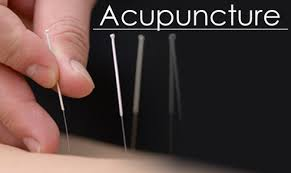
Acupuncture needles are placed on acupuncture points along meridians to balance the energy in the body, helping to improve the flow of energy and fluids. Most fascinating is the skill a TCM practitioner has to learn over time to be able to read the patient’s face, tongue, complexion, posture, and the various levels of the pulse felt along the radial artery. The ancient beliefs on which TCM is based include the following:
- The human body is a miniature version of the larger, surrounding universe;
- Harmony between two opposing yet complementary forces, called yin and yang, supports health, and disease results from an imbalance between these forces;
- Five elements – fire, earth, wood, metal, and water – symbolically represent all phenomena, including the stages of human life, and explain the functioning of the body and how it changes during disease;
- Qi, a vital energy that flows through the body, performs multiple functions in maintaining health.
ONDAMED’s Module 1, the individual frequency list, is based on Eastern and Western philosophies highlighting the correlation between octivated frequencies to organs, organ systems, colors, and sound.
The Frequency chart in Hz as seen in this manual is copyright protected and is the creation of inventor, Rolf Binder. Reviewing the peer reviewed literature available in the early 1990’s, combined with the logic of Pythagoras‘ mathematical structure, and the interpretation of the tempered piano, the list became ONDAMED’s cornerstone and basis for the most of the Module 2 therapeutic programs.
The main correlations of frequency columns directly above the sound (musical note), color, organ/organ system and emotional connections are as follows:

Any frequency combinations which lay between the main frequency columns point to a combination of both columns and their corresponding organs, colors, tones, and emotional connections meaning that the significance of the diagnostic perspective of the found organs/organ systems is less. In other words, when an isolated frequency is found on the main column, the significance of its importance relating to the diagnostic perspective is more.
Please follow this link to see Dr. Binder’s Part 1 Article.
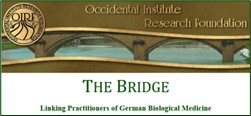 An Exclusive Article for OIRF Supporters
An Exclusive Article for OIRF Supporters
From THE BRIDGE Newsletter of OIRF
Published June 2016
© Copyright 2016, Dr. Silvia Binder, Germany and NY USA

